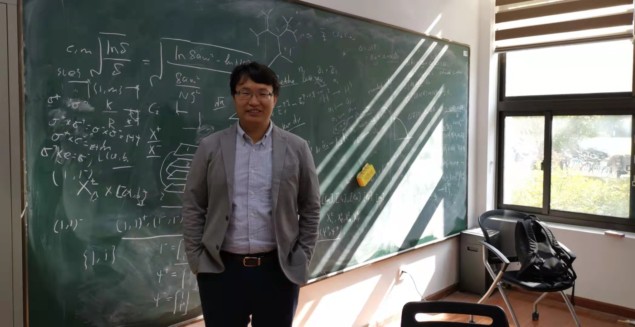Machine learning aids studies of quantum magnets
02 Dec 2021 Margaret Harris
Quantum spin liquid magnets are materials that cannot arrange their magnetic moments, or spins, in a regular, stable pattern because the spins interact in competing ways that cannot be simultaneously minimized. As a result, these “frustrated” spins constantly change direction, behaving like a liquid even at temperatures close to absolute zero. Such behaviour is predicted to give rise to many interesting physical phenomena, but despite great efforts in both experimental and theoretical studies, there is no well-recognized, real-world example of a frustrated magnet hosting a quantum spin liquid state.
In a recent paper published in Chinese Physics Letters, Sizhuo Yu, Yuan Gao, Bin-Bin Chen and Wei Li describe how machine-learning techniques can help us understand how quantum spin liquids behave, and thereby support experimentalists in their study of “candidate” materials that may (or may not) be quantum spin liquids. Here, they discuss their research and goals for the future.
What was the motivation of your research?
The study of strongly correlated quantum materials such as frustrated magnets is challenging yet important for condensed-matter physics as well as quantum science and technology. For example, magnetic quantum materials – especially frustrated magnets in two dimensions – can host highly entangled quantum states and emergent excitations called anyons that follow fractional statistics and can be used to store and manipulate quantum information in a robust, error-resistant manner. Highly frustrated magnets thus provide an intriguing platform for next-generation quantum technologies, including but not limited to topological quantum computation.
One key step in the search for quantum spin liquids in frustrated magnets is to determine the realistic description – the microscopic spin models – of the quantum magnets. These models are like a genome for quantum magnetism – they tell us what types of magnetism are possible. However, inferring the spin model from experimental measurements constitutes a notoriously hard inverse many-body problem. This hinders a precise understanding of spin-liquid candidate materials, including the most prominent ones like the triangular magnet YbMgGaO4, the Kitaev material α-RuCl3, and the Kagome magnet ZnCu3(OH)6Cl2, among others.
What did you do in the paper?
Inspired by recent successes in interdisciplinary research between quantum many-body calculations and machine learning, we proposed an efficient solution for this long-standing problem that greatly facilitates studies of intriguing quantum magnets. Our approach combines accurate many-body methods with highly efficient global optimizers (including the Bayesian and multi-restart auto-gradient strategies) so that we “learn” the effective spin model from the thermodynamic data measured in experiments. This method will not only interest theorists in the quantum many-body physics community, but also experimentalists working on quantum materials.
As part of our research, we also created and made public an open-source many-body calculation package, dubbed QMagen, that includes several state-of-the-art and original many-body methods we developed. Our hope is that such a package can be widely used in the studies of correlated quantum materials.
What was the paper’s most important finding?
We found that we could accurately reproduce the model parameters of a triangular quantum magnet, TmMgGaO4, as determined in a hand-tuned fitting of thermodynamics (see, for example, this paper from 2020), and we confirmed that these previously-determined parameters are located right in the only optimal regime that describes the compound in a rather large parameter space. More recently, we used this same combinative approach to pin down the effective spin model of α-RuCl3, which has interaction parameters that are much debated and quite challenging to determine otherwise. Using QMagen, we find very accurate modelling that convincingly reproduces major experimental observations such as those published earlier this year in Nature Communications.
With these exciting results, we are thrilled by how much computational resource we could save in tackling such tough problems with our approach – including some that are practically impossible to deal with using hand-tuned fittings – and by producing unbiased results free of personal preference.
Why is this research significant?
The framework we proposed creates new possibilities in the research of frustrated quantum magnets and correlated materials in general. With this methodology, it becomes possible to determine the magnetic interactions of 1D and 2D materials in a very efficient manner, which constitutes a very important step towards understanding these low-dimensional quantum magnets and lays down a solid foundation for their applications in future technologies.READ MORE

What do you plan to do next?
We hope this method can contribute to the exploration of exotic states and phase transitions in frustrated quantum magnetism. We will apply this method to more cases of intriguing low-dimensional magnets and try to decode their accurate spin model descriptions – the magnetism genome. The ultimate goal is to establish a genome library for a vast family of quantum magnets. To achieve this, we plan to make continuous improvements and upgrades to our QMagen package.

Margaret Harris is an online editor of Physics World
23/12/2021 physicsworld.com

Δεν υπάρχουν σχόλια:
Δημοσίευση σχολίου